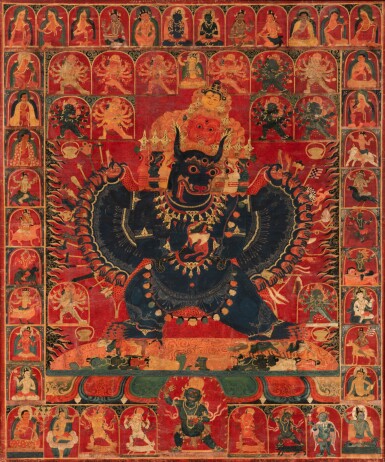Himalayas: The Richard R. & Magdalena Ernst Collection of Important Tibetan Paintings and other Himalayan Works of Art
Himalayas: The Richard R. & Magdalena Ernst Collection of Important Tibetan Paintings and other Himalayan Works of Art

Property from the collection of Richard R. and Magdalena Ernst | 恩斯特伉儷收藏
A rare and important thangka depicting Ekavira Vajrabhairava, Tibet, 15th century | 西藏 十五世紀 獨雄大威德金剛唐卡 設色布本
Lot Closed
December 15, 11:25 AM GMT
Estimate
70,000 - 90,000 EUR
Lot Details
Description
Property from the collection of Richard R. and Magdalena Ernst
A rare and important thangka depicting Ekavira Vajrabhairava
Tibet, 15th century
distemper on cloth, the ithyphallic dark blue buffalo-headed deity, wearing gem-encrusted jewellery and human bone adornments, a garland of severed heads and snakes, with eight further multi-coloured faces, thirty-two arms with a panoply of ritual implements held in the outstretched hands, lunging in pratyalidha with sixteen legs trampling birds and animals and prostrate Hindu deities, all supported by a lotus pedestal against a flaming background filled with twelve multi-armed retinue deities in yab-yum and Manjushri above, with Vajradhara in the upper register together with mahasiddha, Indian pandita and Tibetan lamas, Hindu deities as guardians in the side registers, including Indra on the elephant vahana Airavata, Vishnu, Agni, Yama, Nairrita, Varuna, Vayu, Kubera, Ganesha, Ishana, Surya, Chandra and Prithvi, a Tibetan donor monk officiating below with Yama Dharmaraja and retinue in the lower register
97 x 72.5 cm, 38 1/4 by 28 1/2 in.
__________________________________________________________________________
Collection Richard R. et Magdalena Ernst
Rare et important tangka représentant Ekavira Vajrabhairava, détrempe sur toile, Tibet, XVe siècle
__________________________________________________________________________
恩斯特伉儷收藏
西藏 十五世紀 獨雄大威德金剛唐卡 設色布本
Amy Heller, Tibetan Art: Tracing the Development of Spritual Ideals and Art in Tibet, Milan, 1999, cat. no. 80.
David Jackson, A Revolutionary Artist of Tibet: Khyentse Chenmo of Gongkar, New York, 2016, p. 306, fig. no. 13.2.
Himalayan Art Resources item no. 8003.
__________________________________________________________________________
Amy Heller,《西藏藝術 : 探索西藏靈性和藝術之發展》,米蘭,1999年,編號80
David Jackson,《西藏革命性藝術家 : Khyentse Chenmo of Gongkar》,紐約,2016年,306頁,圖13.2
喜瑪拉雅藝術資源,物件編號8003
This dynamic thangka depicting the iconic meditational deity of Tibetan Buddhism remains in exceptionally fine condition, retaining the majority of its original gilded relief ornament forming the necklace pendant clasps, gem encrusted crown elements, arm bands, bracelets and anklets: for an assessment of this painting technique, see Robert Bruce-Gardner, “Realizations: Reflections on Technique in Early Central Tibetan Painting”, in Steven M. Kossak and Jane Casey Singer, Sacred Visions: Early Paintings from Central Tibet, New York, 1998, pp. 193-205. Compare the raised gold jewellery on an important early fifteenth century painting in a private collection depicting Buddha flanked by the bodhisattvas Avalokiteshvara and Manjushri, see Amy Heller, Tibetan Art: Tracing the Development of Spiritual Ideals and Art in Tibet, Milan, 1999, cat. nos. 93-4, and compare the raised gold jewellery and the line of the scrollwork behind the niches of an early fifteenth century Vajrapani thangka in the Collection of Donald and Shelley Rubin, see Rob Linrothe and Jeff Watt, Demonic Divine: Himalayan Art and Beyond, New York and Chicago, 2004, p. 254, cat. no. 65.
The painting is one of the earliest representations of Ekavira Vajrabhairava with the subsidiary heads arranged in a horizontal plane with a single red wrathful face emerging from the flaming hair and the peaceful face of Manjushri above. The style, described as zhal kor, is developed from the arrangement in which the heads are stacked above the central buffalo face (zhal tseg) as seen in earlier representations of the deity associated with the Sakya, Marpa Kagyu, Jonang and Shangpa Kagyu traditions, see Jeff Watt, Himalayan Art Resources, Vajrabhairava Faces Outline Page. This style development is associated with the Gelukpa tradition. Indeed, a painting in the Rubin Museum of Art depicting Tsongkhapa (1357-1419), the founder of the Geluk order, displays a number of stylistic similarities to the Vajrabhairava, see David P. Jackson, Mirror of the Buddha: Early Portraits from Tibet, New York, 2011, p. 90, fig. 3. 17. The format of niches arranged geometrically around the central figure is similar in each painting, as is the inclusion of numerous Indian pandita wearing yellow caps in the upper registers. The elaborate scrolling embellishment of the lotus petals on the thrones is closely comparable in both examples, as is the overall palette.
Compare also the geometric arrangement of niches, the golden jewellery of the deities and the scrolling lotus petal design on a fifteenth century painting of Tsongkhapa, Manjushri and Maitreya in the Zimmerman Family Collection, ibid, p. 92. fig. 3. 18. Stylistic similarities with these two paintings of Tsongkhapa, together with the iconographical arrangement of the heads in the manner made popular by the Gelukpa, suggests that the Vajrabhairava was probably painted for a Gelukpa patron.
Ekavira Vajrabhairava is the fearsome manifestation of the bodhisattva Manjushri, the Buddhist lord of transcendent wisdom. With skull cup and flaying knife in his principal hands, the buffalo-headed deity bellows with open mouth and fangs bared, proclaiming triumph over ignorance and suffering. Multiple arms, heads and trampling legs symbolise mastery over all elements that bind sentient beings to the wheel of existence, the constant cycle of birth and death, passions, desires and fears. The bull’s head signifies the deity’s conquest of the buffalo-headed god Yama, the lord of death in ancient Indian mythology, thus eliminating the conceptual obstacle of death, yama-antaka, through the enlightened Buddhist condition of transcendent wisdom. Tibetan inscriptions along the lower edge of the painting pay homage to Vajrabhairava and his entourage, and express hopes for spiritual realisation and joy to all sentient beings, see Amy Heller, op. cit, p. 148.
__________________________________________________________________________
本幅唐卡描繪藏傳佛教標誌性冥想神祇獨雄大威德金剛,造型生動活潑。其品相狀況十分良好,保留大部分原有的鋪金浮雕裝飾,組成項鍊、吊墜扣、鑲寶石之皇冠元素、手臂、手鐲和腳環,難得可貴。關於此繪畫技巧評估,見Robert Bruce-Gardner,《實現:對⻄藏中部早期繪畫技術之反思》,另見Steven M. Kossak 和 Jane Casey Singer,《神聖的願景:早期⻄藏的繪畫》,紐約, 1998年,193 - 205頁。相較另一幅重要私人收藏,年代為十五世紀早期,描繪一尊側身為觀音菩薩和文殊菩薩的佛像,畫布上可見相似鋪金浮雕工藝,見Amy Heller,《⻄藏藝術:探索⻄藏靈 性和藝術之發展》,米蘭,1999年,編號80。再比一例,唐納德和雪莉 · 魯賓收藏中一幅十五世紀早期金剛手菩薩唐卡,鋪金浮雕部分和壁龕後方的捲軸線條均十分雷同,見Rob Linrothe 和 Jeff Watt,《惡魔的神性:喜馬拉雅藝術及超越》,紐約和芝加哥,2004年,254頁,編號65。
本幅獨雄大威德金剛像,其造型包括並排的分身頭像、火燄般髮絲中蹦出的憤怒紅臉、及文殊菩薩慈悲之面,本唐卡為此類構圖最早畫作之一。此堆疊風格稱之為Zhal Kor,構圖以水牛臉(zhal tseg)為中心向上延展,正如早期薩迦派、瑪爾巴噶舉派、喬南和香巴噶舉派等繪製神祇的傳統構圖形式,見Jeff Watt,喜馬拉雅藝術資源,獨雄大威德金剛面部輪廓頁面。此風格之發展與格魯派傳統息息相關。魯賓藝術博物館所藏之魯派創始宗喀巴(1357 - 1419)肖像唐卡,風格上與本唐卡有許多相仿之處,見David P. Jackson《佛之鏡:⻄藏早期肖像》,紐約,2011年,90 頁,圖3. 17。畫中壁龕均採用幾何排列,例如印度黃帽潘多拉圍繞於獨雄大威德金剛。此外,兩幅畫中的蓮花瓣設計和整體色調均十分相似。
另比較一例十五世紀唐卡,來自齊默爾曼家族之收藏,描繪宗喀巴、文殊菩薩和彌勒菩薩像。畫中壁龕的幾何排列、神祇珠寶金飾和蓮花瓣設計均十分相仿,見同上,92頁,圖3.18。本唐卡與上述兩幅宗喀巴畫作風格雷同,均以格魯派所流行的構圖方式排列頭像,由此推測本唐卡應受格魯派僧侶之託而繪製。
獨雄大威德金剛形象令人生畏,是佛教超然智慧之主文殊菩薩的化身。這尊水牛頭神靈手持頭骨杯和剝皮刀,張口結舌,宣稱戰勝了無知和痛苦。眾生無止境地受生死、激情、慾望和恐懼等情感束縛,神靈的千手、千頭、千足象徵著對眾生輪迴的主宰掌控。此畫面同時也意味著牛頭神靈駕馭水牛頭閻摩法王-古印度神話中的死亡主宰,通過佛教醒悟的大智慧,消除死亡的黑暗面yama-antaka。本唐卡下方以藏文向獨雄大威德金剛及護法表示敬意,同時表達對眾生靈性和快樂的期望,見Amy Heller,同上,第148頁。
